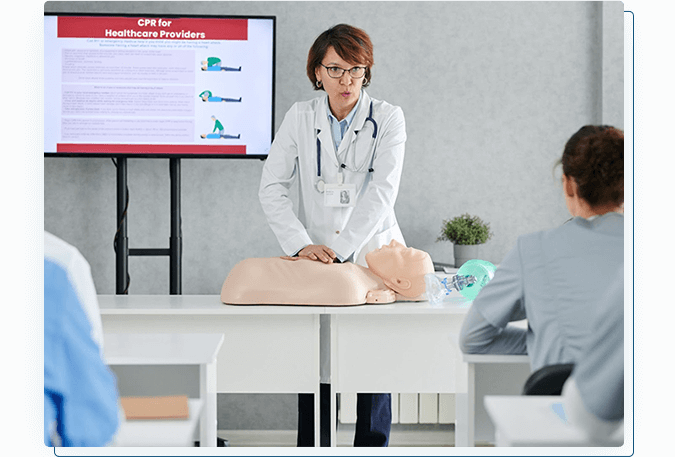In recent years, lifesaving courses and practices have evolved significantly. This remarkable progress is owed to years of research and progressive advancements. The discoveries and innovations have changed the way people approach and administer life saving practices. The goal being positive patient outcomes in emergencies, the US alone contributes to the largest number of publications on CPR research. With smart devices and wearable technology, latest trends have made personalized training experiences possible. In this blog we will be exploring the top trends in CPR and first aid training along with their contribution to emergency response.
What are the emerging trends in CPR?
The evolving trends in the field of CPR training is driven by technological advancements. These trends are not only committing to a broader range of aspiring learners, but also changing the landscape of CPR education. Let’s go through these emerging trends one by one-
- Hands-Only CPR: There is a growing emphasis on hands-only CPR, focusing solely on chest compressions without rescue breaths. This trend simplifies the technique and makes it more accessible to bystanders. It also increases the likelihood of timely intervention.
- Virtual Reality (VR) Training: The integration of virtual reality in CPR training provides realistic simulations, allowing learners to practice in immersive environments.
- Smart Devices and Wearables: The use of smart devices and wearables during CPR training provides real-time feedback on compression depth, rate, and overall performance.
- Community-Based Training Programs: To address accessibility challenges, there is a trend toward community-based CPR training programs. These initiatives bring life-saving skills directly to local communities.
- Psychological Preparedness: Acknowledging the emotional stress associated with emergencies, emerging trends in CPR training include a focus on psychological preparedness. This involves addressing the psychological aspects of responding to life-threatening situations.
- Integration of AED (Automated External Defibrillator) Training: With an increasing number of AEDs in public spaces, there is a trend towards integrating AED training into CPR programs.
- Online and Blended Learning: The adoption of online and blended learning formats is on the rise, providing flexible options for CPR training. This particular advancement allows individuals to acquire life-saving skills at their own pace, catering to diverse learning preferences and schedules.
Read More: CPR certification for Construction Workers
What are the emerging trends in First Aid training?
First aid training courses have gone through transformative changes. The trends have led to the change in educational methods, practices and approaches. These trends greatly prioritize accessibility, and motivates individuals to act effectively in moments of crisis. Let’s find out the key emerging trends in First Aid training-
- Hands-On Simulations: Training now includes interactive simulations with real-life scenarios, allowing learners to practice and build confidence in applying First Aid techniques.
Read More: CPR and Rescue Breaths, Know the basic difference.
- Mobile Applications: There’s a rise in mobile apps dedicated to First Aid training, offering on-the-go resources, step-by-step guides, and interactive quizzes for a more engaging learning experience.
- Mental Health First Aid: First Aid training increasingly integrates Mental Health First Aid, teaching individuals how to provide initial support to those facing mental health challenges or crises.
- Technology in Assessment: The use of wearables and smart devices during assessments provides objective feedback on skills, enhancing the learning process.
- Community-Centric Initiatives: A trend towards community-based First Aid training brings education directly to local communities, addressing specific needs and fostering collective responsibility for emergency response.
- CPR Integration: CPR training is seamlessly integrated into general First Aid courses, ensuring individuals are well-equipped to respond comprehensively in emergencies.
- Diverse Learning Styles: Training is adapted to accommodate diverse learning styles, incorporating visual aids, practical demonstrations, and interactive discussions.
- Online Learning Modules: The adoption of online modules allows individuals to access First Aid training conveniently, providing flexibility in learning schedules.
- Incorporation of Basic Life Support (BLS): First Aid courses are expanding to include Basic Life Support, covering fundamental medical interventions to sustain life.
- Introduction of AED (Automated External Defibrillator) Training: Given the widespread availability of AEDs in public spaces, there’s a growing emphasis on integrating AED training into First Aid courses. This ensures individuals are proficient in using these devices for life-saving interventions.
- Cultural Sensitivity Training: Acknowledging diverse communities, First Aid programs now include elements of cultural sensitivity. Responders are trained to navigate and respect different cultural beliefs and practices when delivering aid in emergencies.
Read More: Are you aware of the CPR/First Aid test quiz?
Conclusion
The trends and advancements have created a transformative shift, especially in the healthcare setting. Utilizing technology and innovation to increase accessibility, these lifesaving courses have redefined emergency response. Top trends in CPR and first aid training reflect the commitment to staying prepared and ready. The integration of technology has also significantly altered the way lifesaving courses are taught. Awareness and education on CPR or First Aid is now fun and engaging. Students are motivated through contests, rewards, points and recognition. These trends and advancements are solely responsible for shaping the future of CPR and First Aid training. Let’s not forget the collective aim is to make a significant difference in the lives of people who come across life threatening emergencies.













